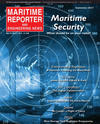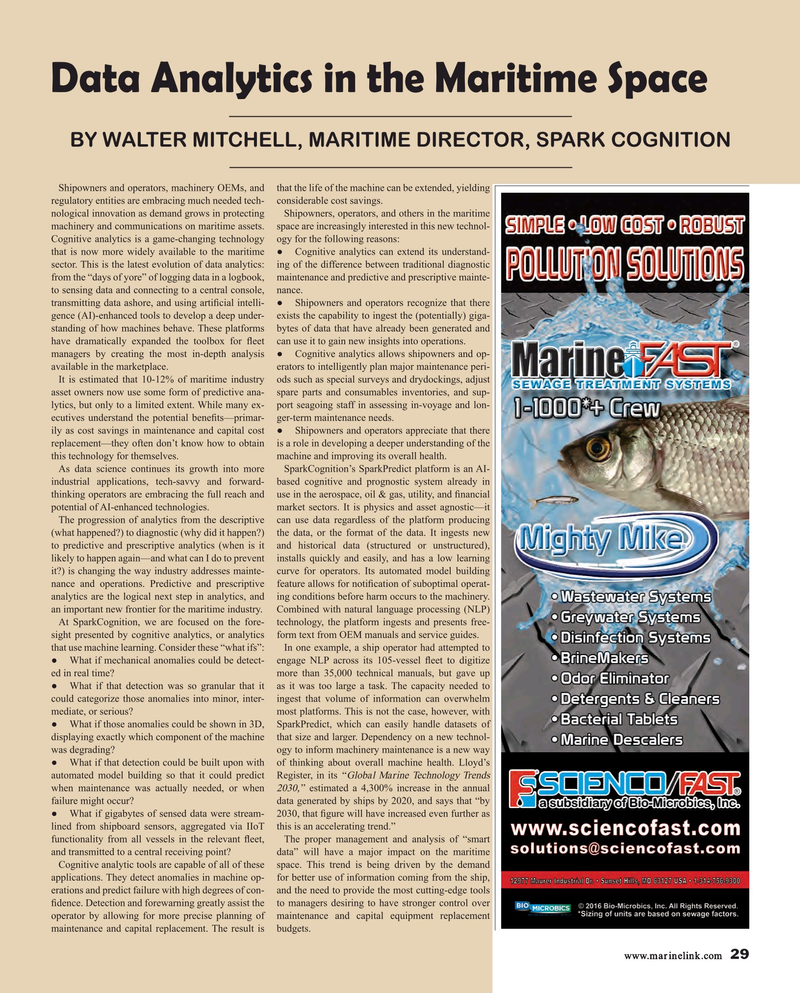
Page 29: of Maritime Reporter Magazine (September 2017)
U.S. Navy Quarterly
Read this page in Pdf, Flash or Html5 edition of September 2017 Maritime Reporter Magazine
Data Analytics in the Maritime Space
BY WALTER MITCHELL, MARITIME DIRECTOR, SPARK COGNITION
Shipowners and operators, machinery OEMs, and that the life of the machine can be extended, yielding regulatory entities are embracing much needed tech- considerable cost savings.
nological innovation as demand grows in protecting Shipowners, operators, and others in the maritime machinery and communications on maritime assets. space are increasingly interested in this new technol-
Cognitive analytics is a game-changing technology ogy for the following reasons: that is now more widely available to the maritime ? Cognitive analytics can extend its understand- sector. This is the latest evolution of data analytics: ing of the difference between traditional diagnostic from the “days of yore” of logging data in a logbook, maintenance and predictive and prescriptive mainte- to sensing data and connecting to a central console, nance.
transmitting data ashore, and using arti? cial intelli- ? Shipowners and operators recognize that there gence (AI)-enhanced tools to develop a deep under- exists the capability to ingest the (potentially) giga- standing of how machines behave. These platforms bytes of data that have already been generated and have dramatically expanded the toolbox for ? eet can use it to gain new insights into operations.
managers by creating the most in-depth analysis ? Cognitive analytics allows shipowners and op- available in the marketplace. erators to intelligently plan major maintenance peri-
It is estimated that 10-12% of maritime industry ods such as special surveys and drydockings, adjust asset owners now use some form of predictive ana- spare parts and consumables inventories, and sup- lytics, but only to a limited extent. While many ex- port seagoing staff in assessing in-voyage and lon- ecutives understand the potential bene? ts—primar- ger-term maintenance needs.
ily as cost savings in maintenance and capital cost ? Shipowners and operators appreciate that there replacement—they often don’t know how to obtain is a role in developing a deeper understanding of the this technology for themselves. machine and improving its overall health.
As data science continues its growth into more SparkCognition’s SparkPredict platform is an AI- industrial applications, tech-savvy and forward- based cognitive and prognostic system already in thinking operators are embracing the full reach and use in the aerospace, oil & gas, utility, and ? nancial potential of AI-enhanced technologies. market sectors. It is physics and asset agnostic—it
The progression of analytics from the descriptive can use data regardless of the platform producing (what happened?) to diagnostic (why did it happen?) the data, or the format of the data. It ingests new to predictive and prescriptive analytics (when is it and historical data (structured or unstructured), likely to happen again—and what can I do to prevent installs quickly and easily, and has a low learning it?) is changing the way industry addresses mainte- curve for operators. Its automated model building nance and operations. Predictive and prescriptive feature allows for noti? cation of suboptimal operat- analytics are the logical next step in analytics, and ing conditions before harm occurs to the machinery. an important new frontier for the maritime industry. Combined with natural language processing (NLP)
At SparkCognition, we are focused on the fore- technology, the platform ingests and presents free- sight presented by cognitive analytics, or analytics form text from OEM manuals and service guides.
that use machine learning. Consider these “what ifs”: In one example, a ship operator had attempted to ? What if mechanical anomalies could be detect- engage NLP across its 105-vessel ? eet to digitize ed in real time? more than 35,000 technical manuals, but gave up ? What if that detection was so granular that it as it was too large a task. The capacity needed to could categorize those anomalies into minor, inter- ingest that volume of information can overwhelm mediate, or serious? most platforms. This is not the case, however, with ? What if those anomalies could be shown in 3D, SparkPredict, which can easily handle datasets of displaying exactly which component of the machine that size and larger. Dependency on a new technol- was degrading? ogy to inform machinery maintenance is a new way ? What if that detection could be built upon with of thinking about overall machine health. Lloyd’s automated model building so that it could predict Register, in its “Global Marine Technology Trends when maintenance was actually needed, or when 2030,” estimated a 4,300% increase in the annual failure might occur? data generated by ships by 2020, and says that “by ? What if gigabytes of sensed data were stream- 2030, that ? gure will have increased even further as lined from shipboard sensors, aggregated via IIoT this is an accelerating trend.” functionality from all vessels in the relevant ? eet, The proper management and analysis of “smart and transmitted to a central receiving point? data” will have a major impact on the maritime
Cognitive analytic tools are capable of all of these space. This trend is being driven by the demand applications. They detect anomalies in machine op- for better use of information coming from the ship, erations and predict failure with high degrees of con- and the need to provide the most cutting-edge tools ? dence. Detection and forewarning greatly assist the to managers desiring to have stronger control over operator by allowing for more precise planning of maintenance and capital equipment replacement maintenance and capital replacement. The result is budgets.
www.marinelink.com 29
MR #9 (26-33).indd 29 MR #9 (26-33).indd 29 9/6/2017 2:05:18 PM9/6/2017 2:05:18 PM

 28
28

 30
30
